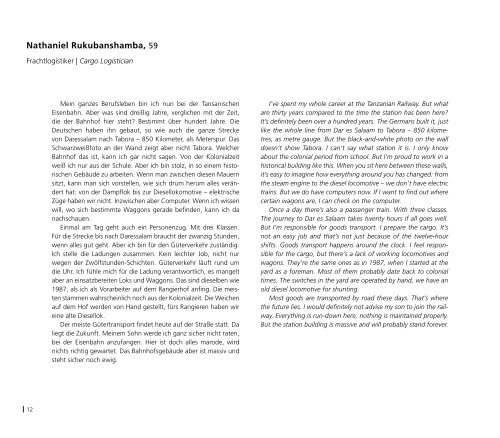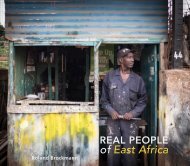Real People of East Africa. Roland Brockmann
From 2016 - 2017 I made four trips through Kenya and Tanzania - travelling over land by minibus, motorbike taxi or on foot. Not to search for something, but to meet the existing, was a great adventure. This photo & text book is about the people I met along my way. They talk about what concerns them: success, failure, love, hope... everyday life. The photos show the people in their living or working environment. And always at eye level. Comming out in december at Photo Edition Berlin. With Essays from Alexis Malefakis and Meja Mwangi. Hardcover. 24 x 21 cm, 112 Pages, 49 images. Language: German/English.
From 2016 - 2017 I made four trips through Kenya and Tanzania - travelling over land by minibus, motorbike taxi or on foot. Not to search for something, but to meet the existing, was a great adventure. This photo & text book is about the people I met along my way. They talk about what concerns them: success, failure, love, hope... everyday life. The photos show the people in their living or working environment. And always at eye level. Comming out in december at Photo Edition Berlin. With Essays from Alexis Malefakis and Meja Mwangi. Hardcover. 24 x 21 cm, 112 Pages, 49 images. Language: German/English.
Create successful ePaper yourself
Turn your PDF publications into a flip-book with our unique Google optimized e-Paper software.
Nathaniel Rukubanshamba, 59<br />
Frachtlogistiker | Cargo Logistician<br />
Mein ganzes Berufsleben bin ich nun bei der Tansanischen<br />
Eisenbahn. Aber was sind dreißig Jahre, verglichen mit der Zeit,<br />
die der Bahnh<strong>of</strong> hier steht? Bestimmt über hundert Jahre. Die<br />
Deutschen haben ihn gebaut, so wie auch die ganze Strecke<br />
von Daressalam nach Tabora – 850 Kilometer, als Meterspur. Das<br />
Schwarzweißfoto an der Wand zeigt aber nicht Tabora. Welcher<br />
Bahnh<strong>of</strong> das ist, kann ich gar nicht sagen. Von der Kolonialzeit<br />
weiß ich nur aus der Schule. Aber ich bin stolz, in so einem historischen<br />
Gebäude zu arbeiten. Wenn man zwischen diesen Mauern<br />
sitzt, kann man sich vorstellen, wie sich drum herum alles verändert<br />
hat: von der Dampflok bis zur Diesellokomotive – elektrische<br />
Züge haben wir nicht. Inzwischen aber Computer. Wenn ich wissen<br />
will, wo sich bestimmte Waggons gerade befinden, kann ich da<br />
nachschauen.<br />
Einmal am Tag geht auch ein Personenzug. Mit drei Klassen.<br />
Für die Strecke bis nach Daressalam braucht der zwanzig Stunden,<br />
wenn alles gut geht. Aber ich bin für den Güterverkehr zuständig.<br />
Ich stelle die Ladungen zusammen. Kein leichter Job, nicht nur<br />
wegen der Zwölfstunden-Schichten. Güterverkehr läuft rund um<br />
die Uhr. Ich fühle mich für die Ladung verantwortlich, es mangelt<br />
aber an einsatzbereiten Loks und Waggons. Das sind dieselben wie<br />
1987, als ich als Vorarbeiter auf dem Rangierh<strong>of</strong> anfing. Die meisten<br />
stammen wahrscheinlich noch aus der Kolonialzeit. Die Weichen<br />
auf dem H<strong>of</strong> werden von Hand gestellt, fürs Rangieren haben wir<br />
eine alte Diesellok.<br />
Der meiste Gütertransport findet heute auf der Straße statt. Da<br />
liegt die Zukunft. Meinem Sohn werde ich ganz sicher nicht raten,<br />
bei der Eisenbahn anzufangen. Hier ist doch alles marode, wird<br />
nichts richtig gewartet. Das Bahnh<strong>of</strong>sgebäude aber ist massiv und<br />
steht sicher noch ewig.<br />
I’ve spent my whole career at the Tanzanian Railway. But what<br />
are thirty years compared to the time the station has been here?<br />
It’s definitely been over a hundred years. The Germans built it, just<br />
like the whole line from Dar es Salaam to Tabora – 850 kilometres,<br />
as metre gauge. But the black-and-white photo on the wall<br />
doesn’t show Tabora. I can’t say what station it is. I only know<br />
about the colonial period from school. But I’m proud to work in a<br />
historical building like this. When you sit here between these walls,<br />
it’s easy to imagine how everything around you has changed: from<br />
the steam engine to the diesel locomotive – we don’t have electric<br />
trains. But we do have computers now. If I want to find out where<br />
certain wagons are, I can check on the computer.<br />
Once a day there’s also a passenger train. With three classes.<br />
The journey to Dar es Salaam takes twenty hours if all goes well.<br />
But I’m responsible for goods transport. I prepare the cargo. It’s<br />
not an easy job and that’s not just because <strong>of</strong> the twelve-hour<br />
shifts. Goods transport happens around the clock. I feel responsible<br />
for the cargo, but there’s a lack <strong>of</strong> working locomotives and<br />
wagons. They’re the same ones as in 1987, when I started at the<br />
yard as a foreman. Most <strong>of</strong> them probably date back to colonial<br />
times. The switches in the yard are operated by hand, we have an<br />
old diesel locomotive for shunting.<br />
Most goods are transported by road these days. That’s where<br />
the future lies. I would definitely not advise my son to join the railway.<br />
Everything is run-down here, nothing is maintained properly.<br />
But the station building is massive and will probably stand forever.<br />
12




